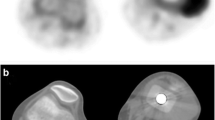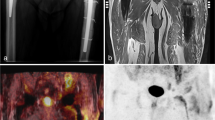Abstract
Background
Metal endoprostheses and internal fixation devices cause significant artifacts on CT after limb salvage surgery; positron emission tomography (PET) images should be evaluated for artifacts.
Objective
(1) To describe [F-18]2-fluoro-2-deoxyglucose (FDG) PET uptake patterns after limb salvage surgery. (2) To determine whether metal endoprostheses and fixation hardware cause significant artifacts on CT attenuation-corrected PET that interfere with diagnostic use of PET/CT after limb salvage surgery.
Materials and methods
We reviewed 92 studies from 18 patients ages 5–21 years. Diagnoses were osteogenic sarcoma in 14, Ewing sarcoma in 3, and malignant peripheral nerve sheath tumor originating in bone in 1. Nine patients had distal femur/knee endoprostheses, five had lower-extremity bone allografts secured by large metal plates and four had upper-extremity limb salvage procedures. Maximum standardized uptake value was calculated at lower-extremity soft-tissue–endoprosthesis interfaces. In 15 patients with PET/CT imaging, the first PET/CT scan after limb salvage surgery was reviewed for metal artifacts on CT images and for artifacts at locations on PET corresponding to the CT metal artifacts.
Results
Increased FDG uptake was consistently present at soft-tissue interfaces with endoprostheses, allografts and internal fixation devices, with little or no FDG uptake at cemented endoprosthesis–bone interfaces. Maximum standardized uptake value at margins of femur/knee endoprostheses ranged from 1.4 to 5.7. In four patients with distal femur/knee endoprostheses, minimal artifact was noted on attenuation-corrected PET images, but image interpretation was not affected. In the other 11 patients who had CT attenuation correction, we detected no artifacts caused by the attenuation correction.
Conclusion
CT attenuation correction did not cause artifacts that affected interpretation of attenuation-corrected PET images.






Similar content being viewed by others
References
Chryssikos T, Parvizi J, Ghanem E et al (2008) FDG-PET imaging can diagnose periprosthetic infection of the hip. Clin Orthop Relat Res 466:1338–1342
Pill SG, Parvizi J, Tang PH et al (2006) Comparison of fluorodeoxyglucose positron emission tomography and (111)indium-white blood cell imaging in the diagnosis of periprosthetic infection of the hip. J Arthroplasty 21 (Suppl 2) 91–97
Bredella MA, Caputo GR, Steinbach LS (2002) Value of FDG positron emission tomography in conjunction with MR imaging for evaluating therapy response in patients with musculoskeletal sarcomas. AJR Am J Roentgenol 179:1145–1150
Sharp S, Shulkin B, Gelfand M et al (2013) Appearance of locally recurrent osteosarcoma after limb salvage surgery (abstract). Pediatr Radiol 43:S353
Goerres GW, Ziegler SI, Burger C et al (2003) Artifacts at PET and PET/CT caused by metallic hip prosthetic material. Radiology 226:577–584
Abdoli M, de Jong JR, Pruim J et al (2011) Reduction of artefacts caused by hip implants in CT-based attenuation-corrected PET images using 2-D interpolation of a virtual sinogram on an irregular grid. Eur J Nucl Med Mol Imaging 38:2257–2268
Lee MJ, Kim S, Lee SA et al (2007) Overcoming artifacts from metallic orthopedic implants at high-field-strength MR imaging and multi-detector CT. Radiographics 27:791–803
Morsbach F, Bickelhaupt S, Wanner GA et al (2013) Reduction of metal artifacts from hip prostheses on CT images of the pelvis: value of iterative reconstructions. Radiology 268:237–244
Ladefoged CN, Andersen FL, Keller SH et al (2013) PET/MR imaging of the pelvis in the presence of endoprostheses: reducing image artifacts and increasing accuracy through inpainting. Eur J Nucl Med Mol Imaging 40:594–601
Schiesser M, Stumpe KDM, Trentz O et al (2003) Detection of metallic implant-associated infections with FDG PET in patients with trauma: correlation with microbiologic results. Radiology 226:391–398
Abella MA, Alessio AM, Mankoff DA et al (2012) Accuracy of CT-based attenuation correction in PET/CT bone imaging. Phys Med Biol 57:2477–2490
Kinehan P, Hasegawa B, Beyer T (2003) X-ray-based attenuation correction for positron emission tomography/computed tomography scanners. Semin Nucl Med 33:166–179
Acknowledgments
Lisa C. Lemen, PhD, and Zhinhua Qi, PhD, gave us valuable assistance by providing a description of the attenuation correction algorithm used by the PET/CT scanner in this study.
Conflicts of interest
None
Author information
Authors and Affiliations
Corresponding author
Rights and permissions
About this article
Cite this article
Gelfand, M.J., Sharp, S.E. [F-18]2-fluoro-2-deoxyglucose (FDG) positron emission tomography after limb salvage surgery: post-surgical appearance, attenuation correction and local complications. Pediatr Radiol 45, 1182–1188 (2015). https://doi.org/10.1007/s00247-015-3290-3
Received:
Revised:
Accepted:
Published:
Issue Date:
DOI: https://doi.org/10.1007/s00247-015-3290-3




